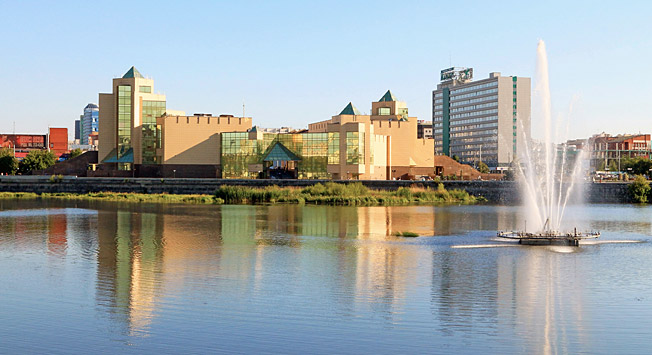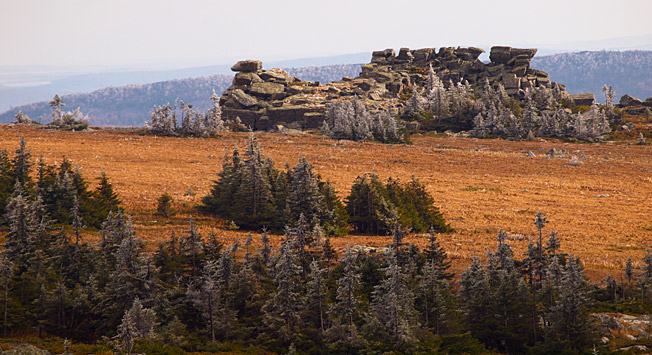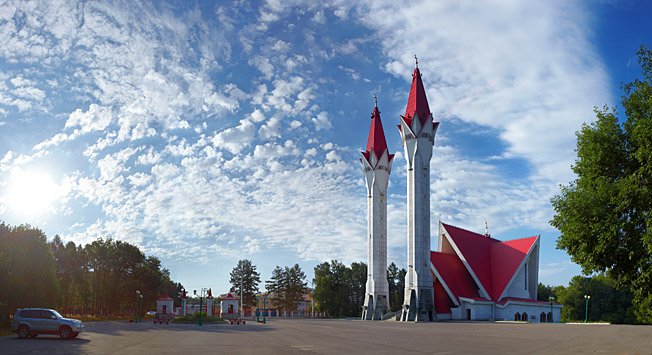Across the continents: Leaving Asia, entering Europe

Follow the Russian Road Trip track in a larger map
Driving towards the Urals, the Tran-Siberian Highway makes a slight detour into Kazakhstan. If you don’t have a multi-entry Russian visa (or a Kazakh visa), take the E-30 highway around northern Kazakhstan. The E-30 reunites with the Trans-Siberian Highway – referred to on signs as the M-51 Federal Highway – just west of the northernmost tip of Kazakhstan in the small Russian town of Makushino. The next major city is Chelyabinsk (five hours, 400 kilometers from Makushino).
Meteors, museums, and mines
A view of Chelyabinsk Local Studies Museum from the Miass river. Photo credit: Lori/Legion-Media
Located on the Miass River, Chelyabinsk is the gateway to the Urals. Although Chelyabinsk briefly captured the world’s attention after a massive meteor crashed nearby in 2013, it is better known as an industrial and mining center and rarely makes it onto travel itineraries. But Chelyabinsk’s location near many of the most stunning parts of the Urals makes it a fine place to base your adventures.
The pedestrian street, ul. Kirova, leads north from Ploshchad Revolyutsii in the heart of Chelyabinsk all the way to the Miass River. The Regional Art Museum has two branches on either end of ul. Kirova, which makes for a pleasant walk if you want to view both parts of the museum. The first location (Pl. Revolyutsii 1) contains the work of Ural artists while the second museum (ul. Truda 92 A), off the northern end of ul. Kirova, features classical art and porcelain. The nearby Local Studies Museum (ul. Truda 100) houses displays on the flora and fauna of the region.
The Park City Hotel (ul. Lesoparkovaya 6) is a modern European-style hotel that provides parking. Standard rooms start at roughly $100 a night.
Into the Urals
Zyuratkul national park, Southern Urals. Photo credit: Lori/Legion-Media
Beyond Chelyabinsk, the M-51 turns into the M-5, which leads into an area of forested mountains and lakes. The waters of Lake Turgoyak (two hours, 120 kilometers from Chelyabinsk) are so transparent that Turgoyak has been nicknamed Lake Baikal’s younger brother. The Golden Beach resort on Turgoyak offers luxurious cabins as well as boat rentals, fishing, horseback riding and a seasonal ski slope nearby. Contact the Empire of Tourism travel agency to book a stay at Golden Beach.
The mountains outside Chelyabinsk are also home to several beautiful parks. The town of Zlatoust (two hours, 145 kilometers from Chelyabinsk) is the jumping off point for the Taganay National Park where you can hike some of the tallest mountains in the Urals. You can arrange to stay at cabins inside Taganay at the park entrance. Ural Expeditions & Tours, based in Yekaterinburg, offers two-day hiking trips in Taganay. Tours cost $380 for a group of six.
Also worth visiting is the slightly more remote Zyuratkul National Park just south of the Trans-Siberian Highway (three hours, 200 kilometers from Chelyabinsk). Inside the park you can hike or relax by Lake Zyuratkul, one of the most picturesque lakes in the Urals. Simple guesthouses can be rented for as little as $10 per day.
Westward to Europe
Lala-Tulpan ('a tulip in bloom') mosque in Ufa. Photo credit: Lori/Legion-Media
From the national parks of the southern Urals, the M-5 leads west to Ufa (4.5 hours, 260 kilometers from Zyuratkul), the capital of the Republic of Bashkortostan. You can make your base in Ufa while exploring the surrounding country or soaking up the culture of the Bashkirs, a Turkic people that have called the area home for centuries.
The Bashkortostan National Museum (ul. Sovetskaya 14) is probably the best spot to start learning about Bashkir history. Continue your exploration of Bashkir heritage by checking out some of Ufa’s unique mosques. Lala Tulpan (ul. Komarova 5) and Sobornaya Ufimskaya (ul. Tukaeva 52) are two of the city’s most prominent.
You can easily visit the nearby national parks and lakes from Ufa, but Chelyabinsk is a better option for making day trips. If you choose to stay in Ufa, Ural Expeditions runs a rafting tour on the nearby Ufa River, with a two-day tour costing $240 for six people.
The Urals represent the biggest landmark of the entire journey across the Trans-Siberian Highway. After 7,500 kilometers of driving from the Sea of Japan, Asia finally disappears behind you.
Welcome to Europe.
All rights reserved by Rossiyskaya Gazeta.
Subscribe
to our newsletter!
Get the week's best stories straight to your inbox